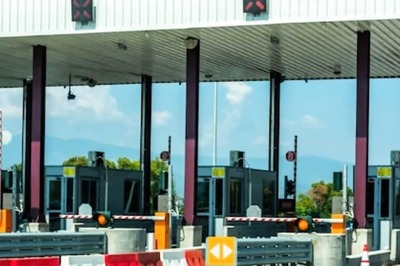
views
Tokyo: The operator of Japan's crippled nuclear plant laid out a blueprint on Sunday for stopping radiation leaks and stabilising damaged reactors within the next six to nine months as a first step toward allowing some of the tens of thousands of evacuees to return to the area.
While the government said the timeframe was realistic, those forced to flee their homes, jobs and farms were frustrated that their exile is not going to end soon. And officials acknowledge that unforeseen complications, or even another natural disaster, could set that timetable back even further.
"Well, this year is lost," said Kenji Matsueda, 49, who is living in an evacuation center in Fukushima after being forced from his home 12 miles (20 kilometers) from the plant. "I have no idea what I will do. Nine months is a long time. And it could be longer. I don't think they really know."
Pressure has been building on the government and plant operator Tokyo Electric Power Co. to resolve Japan's worst-ever nuclear power accident since a catastrophic earthquake and tsunami hit the country March 11, knocking out power and cooling systems at the Fukushima Dai-ichi complex.
On orders from Prime Minister Naoto Kan, TEPCO drew up the blueprint and publicly explained its long-term strategy — for the first time since the disaster — for containing the crisis that has cast a cloud of fear over the country.
"We sincerely apologise for causing troubles," TEPCO Chairman Tsunehisa Katsumata said. "We are doing our utmost to prevent the crisis from further worsening."
Under the roadmap, TEPCO will deal with the crisis in two stages.
In the first stage, the company will focus on cooling the reactors and spent fuel pools and reducing the level of leaking radiation. It will also aim to decontaminate water that has become radioactive, reduce the amount of radiation released into the atmosphere and soil, and lower radiation levels in the evacuation area, Katsumata said.
In the next stage, TEPCO aims to firmly control the release of radioactive materials, achieve a cold shutdown of the reactors and temporarily cover the reactor buildings, possibly with a form of industrial cloth. Longer-term goals include removing fuel from the spent fuel pools and putting permanent covers over the buildings.
TEPCO also plans to establish a system to recycle cooling water that will remove radioactivity as well as corrosive salt left behind by seawater that was earlier used as an emergency cooling measure.
"Given the conditions now, this is best that it could do," said Hidehiko Nishiyama of the government's Nuclear and Industrial Safety Agency, adding that conditions at the facility remain unstable.
Explosions, fires and other malfunctions have hindered efforts to repair the stricken plant and stem radiation leaks.
In a show of support for a staunch American ally, US Secretary of State Hillary Rodham Clinton visited Tokyo on Sunday to express admiration and sympathy for the Japanese.
Clinton had tea with the emperor and empress, who have been visiting evacuation centers to commiserate with the victims of the earthquake and tsunami, which left nearly 28,000 people dead or missing.
"We pledge our steadfast support for you and your future recovery. We are very confident that Japan will demonstrate the resilience that we have seen during this crisis in the months ahead," Clinton said.
She also met with government officials, including Foreign Minister Takeaki Matsumoto, who asked for US feedback on TEPCO's plan to combat the nuclear crisis, Clinton said.
Goshi Hosono, an adviser to the prime minister and member of his nuclear crisis management task force, said the government would closely monitor TEPCO's implementation of the plan and hoped the work could be concluded ahead of the six to nine month schedule. He said he understood people were frustrated by the timeline, but he called it "realistic."
"There is no shortcut to resolving these issues. Though it will be difficult, we have to go step by step to resolve these problems," he said.
Even with the announcement of the timeline, it remained unclear when evacuees might be able to return home.
The area would need to be decontaminated, including removing and replacing the soil, Nishiyama said.
Hosono said the evacuees would not have to stay in gymnasiums for such a long period, but would be moved into temporary housing.
Some evacuees were unswayed by TEPCO's plan.
"I don't believe a word they say," said Yukio Otsuka, 56, a private school owner whose home is about 3 miles (5 kilometers) from the power plant. "I don't trust them. I don't believe it is possible. We have really drawn the short stick on this one."
Activists criticised the delay in the roadmap's announcement.
"TEPCO has taken far too long to provide an indication of the direction it plans to take to bring the situation at Fukushima Dai-ichi under control," said Philip White of the Tokyo-based Citizens' Nuclear Information Center, a group of scientists and activists who have opposed nuclear power since 1975. "We hope TEPCO meets its targets, but there are many challenges ahead and many uncertainties."
The unveiling of the roadmap came two days after TEPCO — also under pressure from Kan's government — announced plans to give 1 million yen ($12,000) in initial compensation to each evacuated household, with much more expected later.
Katsumata, the TEPCO chairman, was hammered Sunday by questions over his managerial responsibility and told reporters he was considering stepping down because of the crisis.
"I feel very responsible," he said.
Kan said in a weekend commentary in the International Herald Tribune that ending the nuclear crisis as soon as possible was his "top priority."
As Japan has begun planning for reconstruction and mulling how to pay for it, Kan's political opponents have resumed calls for his resignation after refraining from criticism in the immediate aftermath of the disaster.
Government officials fanned out across the affected areas over the weekend seeking to explain evacuation decisions and calm nerves. Chief Cabinet Secretary Yukio Edano met Sunday with the governor of Fukushima, who has vigorously protested the predicament the nuclear crisis poses for his prefecture.
"The safety of residents is our foremost priority," Edano said. "I told the governor that the government will do everything it can to prevent the crisis from worsening."
















Comments
0 comment